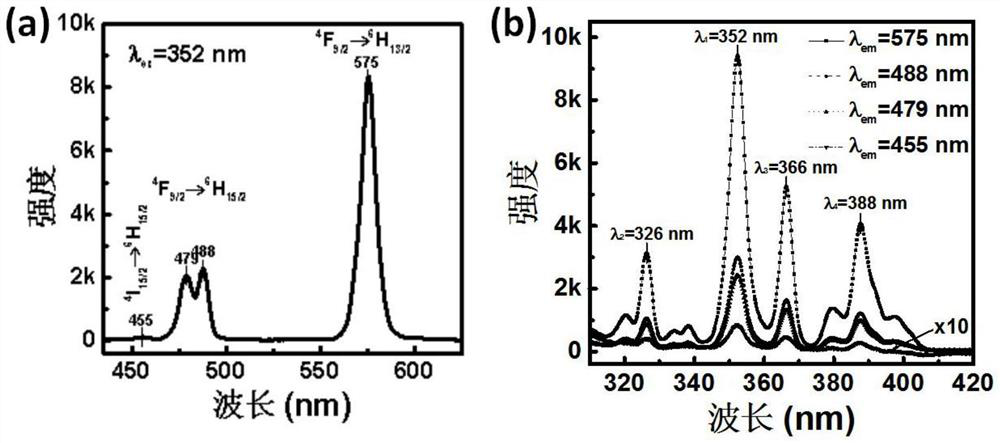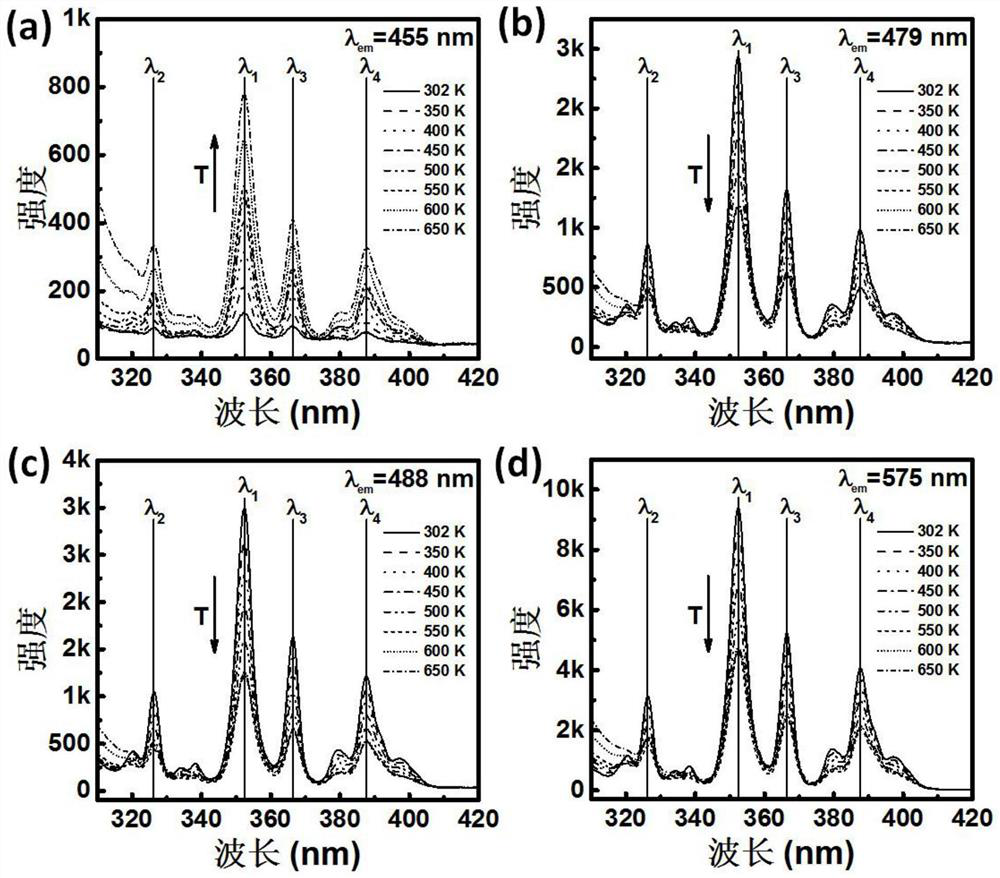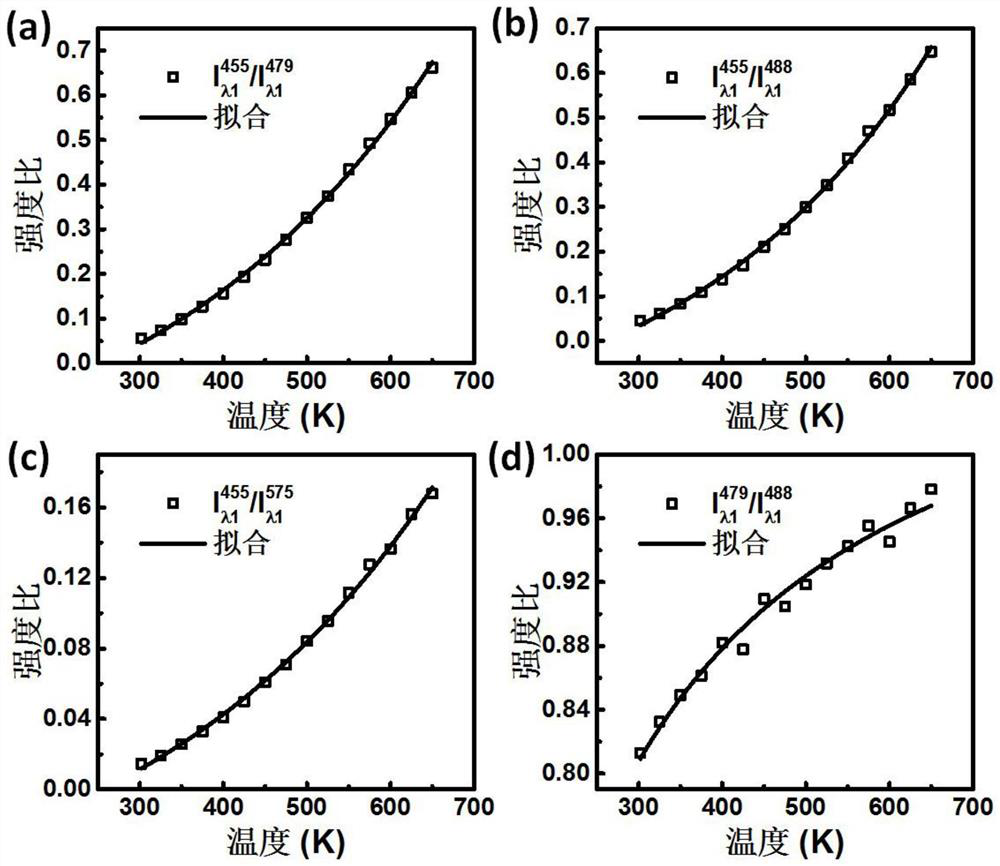Temperature detection method based on excitation intensity ratio of rare earth Dy < 3 + > ions
A detection method and intensity ratio technology, applied in the field of temperature detection, can solve problems such as different temperature sensing characteristics, and achieve the effect of high repeatability and good cycle stability
- Summary
- Abstract
- Description
- Claims
- Application Information
AI Technical Summary
Problems solved by technology
Method used
Image
Examples
Embodiment 1
[0039] image 3 Dy of the present invention is given 3+ Doped with CaWO 4 Phosphors at excitation wavelength λ 1 = 352nm 4 kinds of excitation peak intensity ratios versus temperature. in The variation of the three excitation peak intensity ratios R with the temperature T is obtained by the formula
[0040]
[0041] fit, and The variation of the intensity ratio R with temperature can be obtained by the formula
[0042]
[0043] Fitting is performed, and the fitting constants a, b, and c in equations (1) and (2) are obtained. It can be seen from the figure that in the temperature range of 300-650K, the four excitation peak intensity ratios have a good quantitative relationship with temperature, indicating that based on Dy 3+ The ratio of excitation intensity of ions to temperature can exhibit excellent temperature sensing characteristics in a wide temperature range.
[0044] According to the definition of absolute temperature sensing sensitivity S a =dR / dT, t...
Embodiment 2
[0058] Figure 7 a gives Dy of the present invention 3+ Doped with CaWO 4 Phosphors at excitation wavelength λ 2 = 326nm 4 kinds of excitation peak intensity ratios versus temperature. in The variation of the three excitation peak intensity ratios R with temperature can be fitted by empirical formula (1), The variation of intensity ratio R with temperature can be fitted by formula (2). It can be seen from the figure that in the temperature range of 300-650K, the four excitation peak intensity ratios have a good quantitative relationship with temperature, indicating that Dy 3+ The ratio of excitation intensity to temperature exhibits excellent temperature sensing properties in a wide temperature range.
[0059] Figure 7 b is calculated according to formula (3) and formula (4) based on Dy 3+ Doped with CaWO 4 phosphor Temperature sensing sensitivity curves for 4 excitation peak intensity ratios. It can be seen from the figure that in the whole experimental tem...
Embodiment 3
[0061] Figure 8 a gives Dy of the present invention 3+ Doped with CaWO 4 Phosphors at excitation wavelength λ 3 = 366nm 4 kinds of excitation peak intensity ratios versus temperature. in The variation of the three excitation peak intensity ratios R with temperature can be fitted by empirical formula (1), The variation of intensity ratio R with temperature can be fitted by formula (2). It can be seen from the figure that in the temperature range of 300-650K, the four excitation peak intensity ratios have a good quantitative relationship with temperature, indicating that Dy 3+ The ratio of excitation intensity to temperature exhibits excellent temperature sensing properties in a wide temperature range.
[0062] Figure 8 b is calculated according to formula (3) and formula (4) based on Dy 3+ Doped with CaWO 4 phosphor Temperature sensing sensitivity curves for 4 excitation peak intensity ratios. It can be seen from the figure that in the whole experimental tem...
PUM
| Property | Measurement | Unit |
|---|---|---|
| Sensitivity | aaaaa | aaaaa |
| Sensitivity | aaaaa | aaaaa |
| Sensitivity | aaaaa | aaaaa |
Abstract
Description
Claims
Application Information
 Login to View More
Login to View More - R&D
- Intellectual Property
- Life Sciences
- Materials
- Tech Scout
- Unparalleled Data Quality
- Higher Quality Content
- 60% Fewer Hallucinations
Browse by: Latest US Patents, China's latest patents, Technical Efficacy Thesaurus, Application Domain, Technology Topic, Popular Technical Reports.
© 2025 PatSnap. All rights reserved.Legal|Privacy policy|Modern Slavery Act Transparency Statement|Sitemap|About US| Contact US: help@patsnap.com



